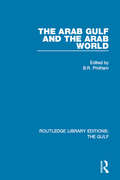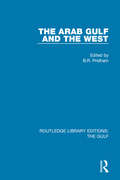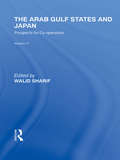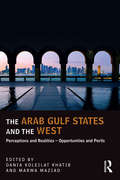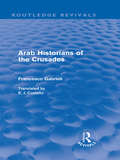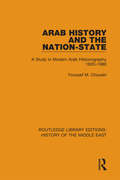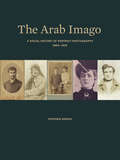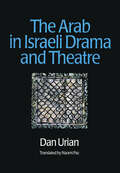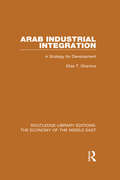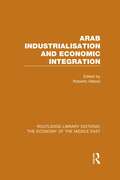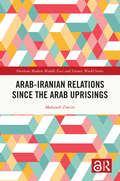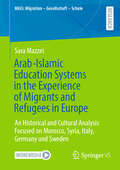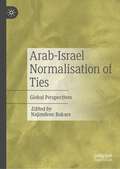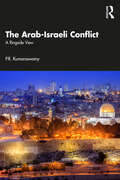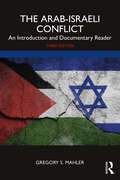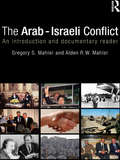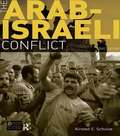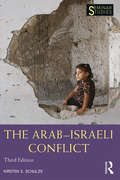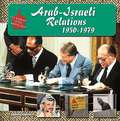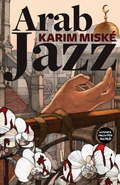- Table View
- List View
The Arab Gulf and the Arab World (Routledge Library Editions: The Gulf Ser. #1)
by B. R. PridhamThis book, first published in 1988, compiles selected contributions to a symposium on ‘The Gulf and the Arab World’ held by the Centre for Arab Gulf Studies at Exeter University, UK, in July 1986. The historical perspective was considered to be a prerequisite for focusing on modern developments, and two chapters are devoted to the coming of both the Arabs and Islam to the Gulf, and a further chapter examines the role of the Ottoman Empire in the region. The remaining chapters concentrate on recent interaction under the broad headings of political and socio-political affairs, demographic aspects, financial interchange and questions of security. A large part of the book is devoted to detailed analysis of the main factor in Arab Gulf/Arab world relations: the huge flow, in one direction, of Arab migratory manpower and, in the reverse direction, of Gulf financing and workers’ remittances.
The Arab Gulf and the West (Routledge Library Editions: The Gulf Ser. #2)
by B. R. PridhamFor many decades the Arab Gulf was considered to be a Western – particularly British – sphere of influence. Much has changed in recent years: the states in the region have come to control their own destinies much more, and Britain has been supplanted by the US as the Western country with the greatest interests in the region. However, the picture has been complicated by differences of opinion within the region and by wider international relations issues. This book, first published in 1985, examines the relations between the Arab Gulf and the West in all their ramifications. Considering the question from historical, economic, cultural and international relations perspectives, it puts forward views both from a Western and a Gulf standpoint. It concludes with a discussion of current trends and likely future developments.
The Arab Gulf Economy in a Turbulent Age (Routledge Library Editions: The Economy Of The Middle East Ser.)
by Hazem BeblawiThe shock discovery of oil in the Gulf States thrust them from relative obscurity to the forefront of international finance and politics. It coincided with the breakdown of the international monetary system and the twin food and energy crisis, all of which helped to magnify the impact of the oil price increases. Yet, despite the continuing oil wealth enjoyed by the Gulf States, their economy has suffered some damaging blows in the recent past. The Iran—Iraq War has imposed a heavy burden on the Gulf countries which have contributed huge sums to Iraq. Internally, the Gulf economies have been hurt by the speculative boom generated by the unofficial stock-market in Kuwait which collapsed in the summer of 1982. This book, by an Arab economist long experienced in working in the Gulf economy, reviews the prospects for the region in the light of these external and internal problems and, drawing on the Kuwaiti example, suggests ways in which changes can be made.First published in 1984.
The Arab Gulf States and Japan (Routledge Library Editions: Japan)
by Walid SharifDuring the 1970s and ‘80s economic relations between the Arab Gulf States and Japan grew enormously. Approximately 65% of Japan’s oil requirements were met from Arab Gulf resources. However, although Japanese imports of Arab oil comprise the major component of trade, Arab imports of Japanese goods are also increasing sharply. The seven Arab Gulf countries, represented by the Petroleum Information Committee accounted for 8% of Japan’s total exports. This book explores the various avenues of economic co-operation that have developed between Japan and the Gulf States both in energy and other areas. It considers the measures that have been taken to protect the security of oil supply. It reports Japan’s co-operation in the development of the petroleum industry in the Arab Gulf States. The book also examines the future prospects for economic, technological and political co-operation between Japan and the Arab Gulf States.
The Arab Gulf States and Reform in the Middle East: Between Iran and the "Arab Spring"
by Yoel GuzanskyThis analysis seeks to analyse the main trends in Gulf security in light of the changes in the regional and international arena, while examining the relationship between external and internal threats, which are intertwined in the Gulf security agenda.
The Arab Gulf States and the West: Perceptions and Realities – Opportunities and Perils (UCLA Center for Middle East Development (CMED) series)
by Dania Koleilat Khatib Marwa MaziadThis book examines the changing image of the Arab Gulf States in the West. It addresses the question of perception in international relations and how the Arab States of the Gulf have pursued various endeavors to project themselves into Western imagination. The book chapters generate ideas on how perceptions came about and ways to improve cultural and political realities on the ground in the Arab Gulf States. Thus, it paves the way for a new area of research in the field of Gulf Studies that extends beyond traditional international relations frameworks by weaving elements of intercultural communication into the mix. Recognizing, yet extending beyond, a traditionally realist framework, which has dominated the analysis of Arab Gulf States' foreign relations with western countries, this book tackles both the materialist and the symbolic in the efforts and initiatives launched by the Arab Gulf States. Some chapters maintain a social-scientific approach about the politics of the Arab Gulf States in the West from an international relations lens. Others employ theoretical frameworks that were founded on the notion of the "encounter," with anthropological lenses and concepts of intercultural communication. In addition to the value of this academic research agenda, as such, some of the chapters also touch upon the added importance of policy-oriented input. As the Arab Gulf States actively engage with the West, the book would widely appeal to students and researchers of Gulf politics and international relations.
Arab Historians of the Crusades (Routledge Revivals)
by Francesco GabrieliThe recapture of Jerusalem, the siege of acre, the fall of Tripoli, the effect in Baghdad of events in Syria; these and other happenings were faithfully recorded by Arab historians during the two centuries of the Crusades. First published in English in 1969, this book presents 'the other side' of the Holy War, offering the first English translation of contemporary Arab accounts of the fighting between Muslim and Christian. Extracts are drawn from seventeen different authors encompassing a multitude of sources: The general histories of the Muslim world, The chronicles of cities, regions and their dynasties Contemporary biographies and records of famous deeds. Overall, this book gives a sweeping and stimulating view of the Crusades seen through Arab eyes.
Arab History and the Nation-State: A Study in Modern Arab Historiography 1820-1980 (Routledge Library Editions: History of the Middle East #1)
by Youssef M. ChoueiriThe study of Arab historiography and of the emergence of the Arab nation-state as an object of historical treatment is a matter of considerable current interest. Despite its importance, no academic work has dealt with this subject as a major preoccupation of Arab historians and intellectuals. This book, first published in 1989, discusses the development of modern Arab historiography and its study of the nation-state in the nineteenth century, and analyses the work of three contemporary Arab historians from Egypt, the Lebanon and Morocco. An important and highly readable account, it reaffirms the importance of historiography and proposes a revision of the manner in which modern Arab thought has hitherto been classified and interpreted.
The Arab Imago: A Social History of Portrait Photography, 1860–1910
by Stephen SheehiThe first history of indigenous photography in the Middle EastThe birth of photography coincided with the expansion of European imperialism in the Middle East, and some of the medium's earliest images are Orientalist pictures taken by Europeans in such places as Cairo and Jerusalem—photographs that have long shaped and distorted the Western visual imagination of the region. But the Middle East had many of its own photographers, collectors, and patrons. In this book, Stephen Sheehi presents a groundbreaking new account of early photography in the Arab world.The Arab Imago concentrates primarily on studio portraits by Arab and Armenian photographers in the late Ottoman Empire. Examining previously known studios such as Abdullah Frères, Pascal Sébah, Garabed Krikorian, and Khalil Raad, the book also provides the first account of other pioneers such as Georges and Louis Saboungi, the Kova Brothers, Muhammad Sadiq Bey, and Ibrahim Rif'at Pasha—as well as the first detailed look at early photographs of the annual pilgrimage to Mecca. In addition, the book explores indigenous photography manuals and albums, newspapers, scientific journals, and fiction.Featuring extensive previously unpublished images, The Arab Imago shows how native photography played an essential role in the creation of modern Arab societies in Egypt, Palestine, Syria, and Lebanon before the First World War. At the same time, the book overturns Eurocentric and Orientalist understandings of indigenous photography and challenges previous histories of the medium.
The Arab in Israeli Drama and Theatre (Contemporary Theatre Studies #Vol. 26)
by Dan UrianWhat is Israeli theatre? Is it only a Hebrew theatre staged in Israel? Are performances by Arab Israelis working in an Arabic theatre framework not part of the repertoire of Israeli theatre? Do they perhaps belong to the Palestinian theatre? What are the "borders" of Palestinian theatre? Are not theatrical works created in East Jerusalem by Arab Israeli playwrights and actors, and staged on occasion before Jewish Israeli audiences, part of a dialogue between Palestinian and Israeli cultures? Does "theatre" only include works staged under that title? These and other similarly absorbing questions arise in Dan Urian's wide-ranging and detailed study of the image of the Arab in Israeli drama and theatre. By the use of extensive examples to show how theatre, politics and personal perceptions intertwine, the author presents us with a model which can be used as a basis for the further discussion and study of similar social and artistic phenomena in other cultures in relation to their theatre and drama.
Arab Industrial Integration: A Strategy for Development (Routledge Library Editions: The Economy Of The Middle East Ser.)
by Elias T. GhantusThe Arab countries are increasingly recognising their importance as a regional economic grouping. Given the highly skewed distribution of natural, human and financial resources, the course of economic development in the Arab countries seems to be interrelated. Through pooling their resources and markets these countries will not only be able to optimise investment decisions but also broaden the potential for development. This book argues that economic integration is not merely a question of reducing or eliminating discriminatory measures, as emphasised in previous integration attempts. It calls rather for a positive action based on a regional investment strategy which coordinates production programmes, to reap the benefits of specialisation and scale. The book focuses on past industrialisation efforts in the Arab countries and examines the emerging patterns of industrial growth. A pioneering attempt is made to identify specific industries whose economic viability can be enhanced by conceiving them on a regional basis. The book concludes by framing a strategy for an integrated industrial development in the Arab region.First published in 1982.
Arab Industrialisation and Economic Integration (Routledge Library Editions: The Economy of the Middle East)
by Roberto AliboniIndependently commissioned by IAI, the three studies comprising this book examine inter-Arab industrial and economic cooperation. The first chapter analyses the industrial strategies, economic policies and attempts at harmonisation and cooperation of the Arab countries, providing a detailed picture of the convergences and divergences, the potential and the difficulties faced by the region. The second chapter examines the importance of coordinating economic polices if economic integration is to be sustained, and considers the implications to the world economy. Lastly, the third chapter examines Arab labour flows, a key factor in the development of the Arab countries. First published in 1979.
Arab-Iranian Relations Since the Arab Uprisings (Durham Modern Middle East and Islamic World Series)
by Mahjoob ZweiriUnlike most writing on Arab-Iran relations, which looks at specific episodes and specific countries, this book, taking a long term view, assesses the overall dynamics of the relationship, discussing in particular how far religion or politics drives the relationship. It argues that although Iran asserts that religion is a key factor underpinning a coherent approach to international relations, in fact what turns out to be the key factor is the politics of particular circumstances and Iran’s specific interests. The book considers Iran’s differing reactions to the Arab uprisings of 2011 onwards, showing that while Iran supported the uprisings in some countries it sided with repressive governments in other countries. The book also examines Iran’s reaction to its own outbreak of popular discontent in 2009 which was controlled by what has been considered as severe repression and explores how Iran is viewed by ordinary people in different Arab countries.
Arab-Iranian Relations Since the Arab Uprisings (Durham Modern Middle East and Islamic World Series)
by Mahjoob ZweiriUnlike most writing on Arab-Iran relations, which looks at specific episodes and specific countries, this book, taking a long term view, assesses the overall dynamics of the relationship, discussing in particular how far religion or politics drives the relationship. It argues that although Iran asserts that religion is a key factor underpinning a coherent approach to international relations, in fact what turns out to be the key factor is the politics of particular circumstances and Iran’s specific interests. The book considers Iran’s differing reactions to the Arab uprisings of 2011 onwards, showing that while Iran supported the uprisings in some countries it sided with repressive governments in other countries. The book also examines Iran’s reaction to its own outbreak of popular discontent in 2009 which was controlled by what has been considered as severe repression and explores how Iran is viewed by ordinary people in different Arab countries.Chapter 1 of this book is freely available as a downloadable Open Access PDF at http://www.taylorfrancis.com under a Creative Commons Attribution-Non Commercial-No Derivatives (CC-BY-NC-ND) 4.0 license.
Arab-Islamic Education Systems in the Experience of Migrants and Refugees in Europe: An Historical and Cultural Analysis Focused on Morocco, Syria, Italy, Germany and Sweden (MiGS: Migration - Gesellschaft - Schule)
by Sara MazzeiIn the last decade, Europe has welcomed numerous migrants and refugees from Arab countries. Their scholastic inclusion has been challenging, and the teaching staff had to sometimes deal with unfamiliar realities. The issue has been addressed by various perspectives, from sociology to psychology, insights from which are gathered in intercultural education. In it, there are scarcity of studies that delve into pupils&’ cultural backgrounds, and countries of origin&’s history is seldom regarded as a decisive factor in the formation of identity. Among Arabic-speaking communities the Moroccan and Syrian ones are the most significant and Morocco and Syria have interesting histories and education systems. Using Nussbaum's (2010) multifactorial analysis, this research aims to better understand the educational universe where Arabic-speaking pupils come from, focusing on humanities and religious education in the experience of pupils, especially from Morocco and Syria. Methodology comprehends qualitative empirical research conducted in Europe. Results show the differences experienced by pupils in their educational paths among diverse Arab and European countries and the more sensitive topics they encounter in their education in Europe in relation to their identity.
Arab-Israel Normalisation of Ties: Global Perspectives
by Najimdeen BakareThis book focuses on rapprochement and normalisation between Israel and some Arab countries within the context of global and regional geopolitics, bringing together broader perspectives on transformations resulting from this. The analysis is rooted in a historical and cultural construction of the region as an Islamic sphere viewing Israel as a perpetuation of the Western colonial project in the region. It analyses how this normalisation must not be treated as a novel phenomenon, but as a reconstruction of the past and continuity in tradition geared at regional stability, signifying a wider shift in the structure of the global international system. The first section addresses the international perspectives of the changing dynamics through the lens of US domestic politics, disengagement plans, China’s increasing understanding of the geopolitics of the Abrahamic world. It equally pays enough attention to the attendant implications of this normalisation. The second section of the book explores the reflections of regional (state and non-state) actors, such as Turkey, Iran, Syria, Pakistan, and Hezbollah, and the catalysing effects of this normalisation within and beyond the region. The book is a rich resource for scholars of regional and international relations, in particular Middle East studies. It provides useful reading material for both undergraduate and graduate students of Political Science, think tanks, diplomats, and IR experts and policy analysts, who are desirous of having rich theoretical and empirical underpinnings of unfolding realities in the larger Middle East.
The Arab-Israeli Conflict: A Ringside View
by P.R. KumaraswamyThis book provides a holistic view of the conflict between Israel and its Arab neighbours and studies the global implications of their fraught relations. Focusing on the conflict from its beginning in the late 19th century, the author provides a well-rounded and balanced narrative by examining its religious, ideological, ethnic, political, national, regional and international dimensions. The volume covers a wide range of issues, such as the conflicting historical legacy of the city of Jerusalem, Jewish longing for a homeland, the partition of Palestine, various wars and conflicts since 1948, Palestinian resistance, the Arab Boycott of Israel and the Abraham Accords. It also tackles the contested national claims and the refugee question and looks at various peace-making efforts, including the role of external stakeholders such as the US, UK, Russia and India. A comprehensive study of the Arab-Israeli conflict, the book is richly supported by a swath of references to materials, documents, maps and video links. It will be an essential reading for students, academics and teachers of politics and international relations, national security, geopolitics, history, military and strategic studies, Middle East studies, conflict resolution and peace-making.
The Arab-Israeli Conflict: An Introduction and Documentary Reader, 2nd Edition
by Gregory S. MahlerThe Arab-Israeli conflict has been one of the most protracted and contentious disputes in modern history. This wide-ranging textbook examines the diplomatic and historical setting within which the conflict developed, from both the Israeli and Palestinian perspectives, and gives a comprehensive overview of the peace process. The new edition includes a fully revised and updated introduction and a wider selection of documents up to the first year of the Trump presidency. Enabling students to easily access and study original documents through the supportive framework of a textbook, The Arab-Israeli Conflict: presents over eighty of the most important and widely cited documents in the history of the Israeli-Palestinian conflict presents these documents in an edited form to highlight key elements includes an introductory chapter which sets the context for the study of the history of the area covers a comprehensive historical period, ranging from the 19th Century to the present day incorporates a wide range of pedagogical aids: original documents, maps and boxed sections. This important textbook is an essential aid for courses on the Arab-Israeli conflict and the Middle East peace process, and will be an invaluable reference tool for all students of political science, Middle East studies and history.
The Arab-Israeli Conflict: An Introduction and Documentary Reader
by Gregory S. MahlerThis textbook examines the diplomatic and historical setting within which the Arab-Israeli conflict has developed and gives students the opportunity to study the Middle East peace process through a presentation of primary documents that have been instrumental in the development of the conflict from the mid1800s through the present. This third edition includes an updated and expanded introduction and a significant expansion of the number of documents. The Arab-Israeli Conflict: • includes an extensive introductory chapter which presents the history of the conflict and covers events from the nineteenth century to the present day • presents 120 of the most important and widely cited documents in the history of the Israeli-Palestinian conflict in an edited form to highlight key elements • incorporates a number of pedagogical aids, including the (edited) original documents, maps, and boxed sections that offer greater explanation of detailed topics • presents “both sides” of the argument, allowing students to understand both the Israeli and the Palestinian positions on the issues This important textbook is an essential aid for courses on the Arab-Israeli conflict and the Middle East peace process and will be an invaluable reference tool for all students of political science, Middle East studies, and history.
The Arab-Israeli Conflict: An Introduction and Documentary Reader
by Gregory S. Mahler Alden R.W. MahlerThe Arab-Israeli conflict has been one of the most protracted and contentious disputes in the Middle East. This wide-ranging textbook examines the diplomatic and historical setting within which the conflict developed, from both the Israeli and Palestinian perspectives, and gives a comprehensive overview of the peace process. Enabling students to easily access and study original documents through the supportive framework of a textbook, The Arab-Israeli Conflict: presents the seventy most important and widely cited documents in the history of the Israeli-Palestinian conflict presents these documents in an edited form to highlight key elements includes an introductory chapter which sets the context for the study of the history of the area covers a comprehensive historical period, ranging from the 19th Century to the present day incorporates a wide range of pedagogical aids: original documents, maps and boxed sections. This important textbook is an essential aid for courses on the Arab-Israeli conflict and the Middle East peace process, and will be an invaluable reference tool for all students of political science, Middle East studies and history.
The Arab-Israeli Conflict
by Kirsten E. SchulzeIn this fully revised new edition, Kirsten Schulze brings us to a new understanding of the causes, course and consequences of the Arab-Israeli Conflict. Schulze analyses the dynamics of the violence and explores the numerous attempts at resolving the conflict. She assesses why, in the cases of Israel-Egypt in 1978 and Israel-Jordan in 1994, negotiations succeeded in bringing about a lasting peace and why, in the cases of Israel, and the Palestinians, Syria and Lebanon, they failed to do so. Written in a clear and accessible style, this fully updated second edition: · Traces the origins of the conflict from their first intellectual roots in the 19th century. · Examines the actions and aims of the competing nationalist movements during the period of the British Mandate which led to the creation of the state of Israel.· Outlines and analyses each of the Arab-Israeli conflicts from the creation of the state of Israel in 1948 to the 2006 Lebanon war and the on-going, second Palestinian uprisingWith a diverse collection of documents and a Chronology, Glossary, Guide to Further Reading, and a Who's Who summarizing the careers and contributions of the main figures, this book is absolutely vital to understanding the current Israeli-Palestinian violence, the intra-Palestinian rift between Hamas and Fatah, and why the Arab-Israeli conflict has become the centre of Muslim politics, both violent and non-violent, across the world.
The Arab-Israeli Conflict (Seminar Studies)
by Kirsten E. SchulzeIn this concise yet comprehensive survey, Kirsten E. Schulze analyzes the causes, course and consequences of the Arab–Israeli conflict, exploring the particular dynamics of this conflict and the numerous attempts at its resolution. Covering pivotal events ranging from the creation of the State of Israel to the first and second Lebanon Wars and the Arab Spring, the book traces the development of the conflict from its intellectual roots in the nineteenth century to the present day. This third edition has been revised throughout to bring the text up to date with recent events, including: • a completely new chapter on the Gaza Wars from 2006 to 2014 • new material on the Arab Spring and its implications for Israel • an updated discussion of the ongoing negotiations for peace. Containing a diverse collection of primary source documents, a chronology of key dates, a glossary, a guide to further reading and a Who’s Who summarizing the careers and contributions of the main figures, this book is essential to understanding the background to and worldwide significance of the continuing violence between Israel and Palestine and is valuable reading for all students of the Arab–Israeli conflict.
The Arab-Israeli Conflict in American Political Culture
by Jonathan RynholdThis book surveys discourse and opinion in the United States toward the Arab-Israeli conflict since 1991. Contrary to popular myth, it demonstrates that U. S. support for Israel is not based on the pro-Israel lobby, but rather is deeply rooted in American political culture. That support has increased since 9/11. However, the bulk of this increase has been among Republicans, conservatives, evangelicals, and Orthodox Jews. Meanwhile, among Democrats, liberals, the Mainline Protestant Church, and non-Orthodox Jews, criticism of Israeli policies toward the Palestinians has become more vociferous. This book works to explain this paradox.
Arab-Israeli Relations, 1950-1979
by Brian BaughanArab-Israeli Relations, 1950-1979 examines the history of relations between Israel and its Arab neighbors, discussing such important events as the 1956 Suez Canal crisis, the June 1967 War, and the 1978 Camp David Accords.
Arab Jazz
by Karim MiskéKosher sushi, kebabs, a second hand bookshop and a bar: the 19th arrondissement in Paris is a cosmopolitan neighbourhood where multicultural citizens live, love and worship alongside one another. This peace is shattered when Ahmed Taroudant's melancholy daydreams are interrupted by the blood dripping from his upstairs neighbour's brutally mutilated corpse. The violent murder of Laura Vignole, and the pork joint placed next to her, set imaginations ablaze across the neighborhood, and Ahmed finds himself the prime suspect. However detectives Rachel Kupferstein and Jean Hamelot are not short of leads. What is the connection between a disbanded hip-hop group and the fiery extremist preachers that jostle in the streets for attention? And what is the mysterious new pill that is taking the district by storm? In this his debut novel, Karim Miské demonstrates a masterful control of setting, as he moves seamlessly between the sensual streets of Paris and the synagogues of New York to reveal the truth behind a horrifying crime.
